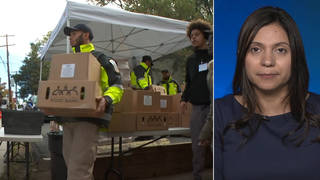
Topics
Guests
- Dave PhilippsPulitzer Prize-winning journalist. He is a national correspondent for The New York Times. His latest piece is headlined “Exposed by Michael: Climate Threat to Warplanes at Coastal Bases.”
On Thursday, Vice President Mike Pence traveled to the Tyndall Air Force Base in Florida, just over a week after the base was largely destroyed during Hurricane Michael. The base is home to a fleet of 55 F-22 stealth fighters. Before Hurricane Michael leveled the base, at least 33 of these jets were flown to safety. But at least 17 of the planes, costing $339 million each, were likely left behind and possibly destroyed. There are several air bases located right on the coast in storm-prone areas in states in the South where scientists anticipate that climate change-induced hurricanes will grow more intense and more frequent. But on Thursday, Mike Pence vowed to rebuild the entire base. We speak to Pulitzer Prize-winning journalist Dave Philipps of The New York Times.
Transcript
AMY GOODMAN: This is Democracy Now! I’m Amy Goodman. On Thursday, Vice President Mike Pence traveled to the Tyndall Air Force Base in the Florida Panhandle, just over a week after the base was largely destroyed during Hurricane Michael. The base is the home of a fleet of 55 F-22 stealth fighters. Before Hurricane Michael leveled the base, at least 33 of these jets were flown to safety, to Ohio, but at least 17 of the planes, costing about a third of a billion dollars each—$339 million each—were likely left behind and possibly destroyed, because they weren’t airworthy at the time.
There are several air bases located right on the coast in storm-prone areas in states in the South, where scientists anticipate climate change-induced hurricanes will grow more intense and more frequent. But on Thursday, Vice President Pence vowed to rebuild the entire base.
To talk more about this issue, we’re joined by Pulitzer Prize-winning journalist Dave Philipps, national correspondent for The New York Times, one of his recent pieces headlined “Exposed by Michael: Climate Threat to Warplanes at Coastal Bases.”
Dave, welcome back to Democracy Now!, as you join us from Colorado. Can you talk about what you understand happened at Tyndall?
DAVE PHILIPPS: Sure. Well, as we know, Hurricane Michael, when it developed, it developed very fast and got much bigger than was predicted, and I think it really caught the Air Force off guard. So, for decades, what the Air Force has done—and also the Navy and the Army and Marines, who all have their own aircraft—what they’ve done when one of their airfields is in harm’s way is fire up the planes and fly them off to safety. In this case at Tyndall, they flew most of their F-22s to an Air Force base in Ohio.
And that works if you can get your planes started, but the F-22 is a very sophisticated and somewhat finicky plane. And according to Air Force reports, only about half of them are mission-ready at any one time. And so, with only a couple days’ notice of this impending storm, they weren’t able to get, we’re hearing, 17 planes going, and so they put them in hangars on the base, and they hoped for the best.
And the best did not happen. When Hurricane Michael hit the coast, it hit directly on Tyndall Air Force Base. And the winds there were measured up to 130 miles an hour before the base’s wind speed measuring equipment broke. So we really don’t know how ferocious the storm really was. But afterwards, the base was flattened. Many of its hangars had their roofs ripped off. Buildings were flooded. I think the Air Force, you know, in its assessment, is saying that the base is almost a complete loss. And these planes that were left behind, the Air Force is being very careful about what it says about it, but they say that many of them are damaged.
AMY GOODMAN: Many of these believed to be, what, 17 F-22s?
DAVE PHILIPPS: Seventeen, which is worth somewhere around $5.8 billion, depending on how you count it. Compare that to replacing the entire base, which would only cost about $1.5 billion by the Air Force’s estimation. So these planes are literally irreplaceable and also just a tremendous cost.
AMY GOODMAN: I mean, you think about this. President Trump has been talking about a caravan of immigrants coming up from Honduras, making its way through Mexico, talking about it as a threat to national security. If people learned that there was an Air Force base on the southern border that was almost leveled, that perhaps 17 of its leading jet fighter planes destroyed, people would say, “Who did that? Who is the enemy?” In fact, what we’re talking about—I mean, talk about the elements of this storm that relate to climate change. The fact that they couldn’t move these planes, that simply weren’t airworthy at that time, but if they had time, the intensity, the frequency, how fast Michael hit the Panhandle?
DAVE PHILIPPS: Well, that’s right. I think—so, the Air Force has been dealing with dangerous storms that damage its bases since the time when the destruction was measured in blimps. They are used to it, and I think they think that it is a cost of doing business. There’s many reasons that the military wants to have airfields down on the coast in the southeastern United States. The question is: How do those costs change if and when storms become more frequent, when they become stronger and when the storm surge that comes in becomes higher? And I think, because there is uncertainty here, they don’t know what to prepare for and how bad it’s going to get. But I think Tyndall was really a wake-up call, because it showed how vulnerable they really are.
AMY GOODMAN: What about Vice President Pence going to the base and saying they’re going to rebuild Tyndall?
DAVE PHILIPPS: I think that you can argue that, in some cases, rebuilding these bases could make sense, if you do it right. Having bases on the coast is helpful for a couple reasons. One, you want to be able to patrol your borders. We sort of take it for granted that we have peaceful borders right now, but that may not always be the case. And, two, the Air Force and all of the services have to do a lot of training. Their aircraft are really loud. Sometimes they’re shooting missiles and shooting down drones, and they need an empty place to do it. And most of the empty places that they use are over the ocean. So it’s hard to just say, “Well, why don’t you move your bases to Ohio or Kansas or Arizona?”
You know, so the question is: If you want to stay, what do you have to do? The Air Force actually has a case study of this. It has an Air Force base on Guam, and that Pacific island is right in the middle of Typhoon Alley. You were talking earlier in the show about the super typhoon that just hit. Well, those types of typhoons have hit Guam repeatedly over the years. And what they’ve done is they have hardened the structures there almost as if they were expecting them to get bombed. Their hangars are built out of heavy steel and concrete. Even the base housing there is built out of concrete so that it can withstand winds over 150 miles an hour, sometimes up to 200.
That type of thing can work, but it takes investment. One of these hangars could cost $100 million. And I think that the problem is, is whether the military will invest. Are they going to get serious about this stuff, and will they have support from the administration to say, “Oh, we need to be prepared for bigger and more frequent storms, and so we need to have an infrastructure that will allow these bases to survive”? I think those are probably discussions that are going on right now at the Pentagon, and we’ll see. I don’t know how they’re going to rebuild.
AMY GOODMAN: Hasn’t it been for a number of years, Dave Philipps, that the Pentagon is fully well aware of the threats of climate change? It’s released reports saying it’s one of the greatest threats to national security in the 21st century. But you still have President Trump doubling down. I mean, of course, in the past he called it a Chinese hoax. What is the significance, the practical effect of this denial, what it means for bases like Tyndall and future ones that could be leveled?
DAVE PHILIPPS: During the Obama administration and, to an extent, during the Bush administration, there was really a push by top leadership to prepare for climate change in the military. That meant making sure that bases were more resilient, that they were looking more at renewable energy and looking more at sea level change.
What I’ve heard from people in the leadership is that that push from the White House is no longer there, but there is still enough inertia within this huge bureaucracy that is the military, that a lot of this stuff is carrying forward. You know, there are a lot of smart people in the military, and they get it. They need to prepare for, like you said, a threat that right now is a much bigger threat to any U.S. bases than any conventional enemy.
So, I think they’re still doing it, but the question is: Will that speed that they carried over from previous administrations slowly diminish without leadership from the top? And, you know, we’ll see. I think that watching how they rebuild Tyndall and look at other air bases is going to be a good test. But certainly, there’s no doubt now that these places are really vulnerable.
AMY GOODMAN: What most surprised you in your reporting, Dave?
DAVE PHILIPPS: You know, so, when these storms were bearing down, they brought their aircraft that they knew weren’t airworthy and put them in their strongest hangars. These were hangars that had survived every storm previously. And I think they hoped for the best, and they left. And when we saw the footage from the air the morning after the storm ripped through, these hangars were just in ribbons. And you could see the planes that were sitting there now covered in debris. And I think, at that point, it was not expected. I wasn’t expecting it. Obviously, they weren’t expecting it. And I think it really showed how much things may be changing.
AMY GOODMAN: Well, Dave Philipps, I want to thank you very much for being with us. Final question: How willing was the Pentagon to admit that, what, nearly $6 billion in some of its most sophisticated stealth fighter jets were destroyed?
DAVE PHILIPPS: They were not willing at all. It took us doing some—they don’t talk about it. It took us doing sleuthing on the ground and some math about where planes were at other bases to figure out that there were a bunch of them missing. And they still haven’t given us any accounting of what kind of damage has happened.
AMY GOODMAN: And you saw the tails, you saw what these F-22s—you knew what they looked like.
DAVE PHILIPPS: Right, right. So we were able to sort of match their silhouettes in the debris.
AMY GOODMAN: Dave Philipps, we want to thank you for being with us, Pulitzer Prize-winning journalist, national correspondent for The New York Times. We’ll link to your piece, “Exposed by Michael: Climate Threat to Warplanes at Coastal Bases.”












Media Options